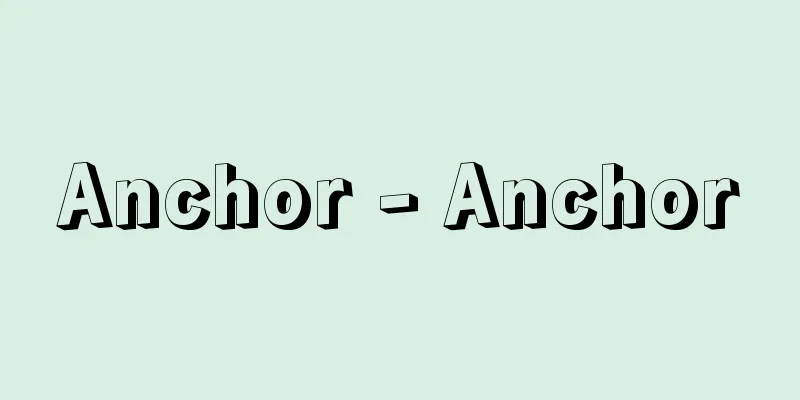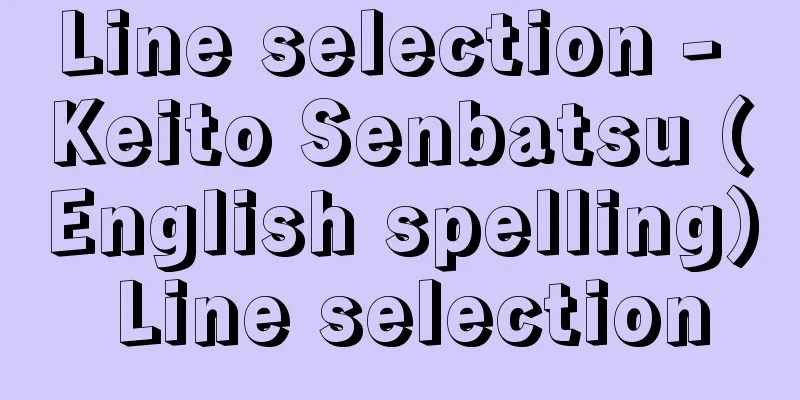Anchor - Anchor

|
An anchor is used to anchor floating objects such as ships, buoys, offshore work platforms, and offshore fishing facilities to a certain place on the sea surface. It is also called an anchor. In the past, stones were used, so the character "ika" (anchor) was used, but nowadays they are made of cast iron or forged steel and have a structure with a claw. The claws used to be tree branches with stones tied to them, so they were called "nekoishi" (cat stone), but when they became iron, they became "nekotetsu" (cat iron), and it is said that these two characters were combined to give rise to the character "anchor." An anchor is dropped to the seabed and connected to a floating object by a chain (anchor chain) or rope to anchor it. [Satoshi Iwai] Uses and typesWhen an anchor is dropped, its claws dig into the seabed and create resistance, countering the currents and wind forces acting on the floating structure. The resistance that an anchor exerts at this time is called holding power, and various designs have been made of its shape to provide a large resistance with good holding efficiency. Anchors used to anchor ships in a certain place for long periods of time, such as buoys or offshore facilities, are designed with a focus on large holding power. Anchors are also used to assist in maneuvering ships when moored alongside a quay or changing direction in narrow waters such as in a harbor, so anchors are designed with shapes and functions that are convenient for handling and storing. For this reason, various types of anchors are used depending on the purpose of their use ( ). Also, on ships, anchors are divided into large anchors (main anchors), medium anchors, and small anchors depending on their purpose, but in recent times, not only small anchors but even medium anchors are rarely used except on small ships. The type, number, and weight of anchors that a ship should have, along with the attached anchor chains, are specified in the Ship Equipment Regulations. On a 10,000-ton ship, large anchors are always kept on the starboard and port sides of the bow, each weighing about 5 tons. The large anchor on the giant tanker Idemitsu Maru (107,321 gross tons) weighed as much as 18 tons. [Satoshi Iwai] Anchor ConfigurationA modern ship's anchor consists of a part that digs into the seabed and creates holding power, that is, two arms with flukes (palms) at the ends and a crown that holds them together, and a shank that connects to the crown to promote digging into the seabed and stabilize the anchor in the direction of the anchor chain's pull. A ring is attached to the end of the shank to connect a chain or rope that will lead the anchor to the surface. In older anchors, the shank and crown are integrated, and these are called stock anchors. A stock is attached to the top of the shank at a right angle to the faces of the two arms, preventing the anchor from tipping over on the seabed, stabilizing its position, and improving holding efficiency. This type of stock anchor was widely used during the era of sailing ships, but as larger anchors become inconvenient to handle and store, stockless anchors are used on modern large ships ( ). In a stockless anchor, the shank is attached so that it rotates and opens at a right angle to the plane of the two arms. When the anchor is dropped and pulled, the two arms open at the same angle and the flukes dig into the seabed together. The size of the opening angle between the shank and the arms is important for improving the anchor's holding efficiency, and is designed to be around 40 degrees so that it can rotate in either direction ( ). Because the crown can rotate in this way, the anchor can be pulled up and placed in the bow so that it fits snugly against the anchor hole, making it easy to handle and store. However, there are also anchors in use today that have stocks attached to them depending on the purpose, improving their holding efficiency. For example, the Dunhorse anchor for small boats has a stock attached to the crown. [Satoshi Iwai] ©Shogakukan "> Main types of anchors (Figure A) ©Shogakukan "> Anchor configuration (Figure B) ©Shogakukan "> How a stockless anchor works (Fig. C) Source: Shogakukan Encyclopedia Nipponica About Encyclopedia Nipponica Information | Legend |
|
船や浮標(ふひょう)(ブイbuoy)、海上作業台や漁業用の海上施設など、浮体を海面上、一定の場所につなぎ止めるために用いるもの。アンカーanchorともいう。昔は石を用いたので「碇」の字が使われたが、現在では鋳鉄や鍛鋼鉄製で、つめをもつ構造になっている。つめは、昔は木の枝が使われ、これに石が結び付けられたものを用いたので、猫石などといわれていたが、鉄になってから猫鉄となり、これが一字となって「錨」の字が生まれたといわれる。海底に投下設置した錨は、それに接続したチェーン(錨鎖(びょうさ)またはアンカーチェーン)やロープで浮体に連結し、これを係止するようになっている。 [岩井 聰] 用途と種類投下した錨は、そのつめが海底に食い込んで抵抗力をつくり、浮体に働く潮流や、風の力に対抗する。このとき錨の発揮する抵抗力を、把駐(はちゅう)力とよんでおり、把駐効率のよい大きな抵抗力を発揮するため、その形状などに、いろいろのくふうがなされている。浮標とか海上施設のように、長期間一定の場所に係止するのに用いられる錨は、把駐力の大きいことに主眼を置いた錨が用いられる。また、岸壁に横づけしたり、港内のように狭い水域で方向変換をするような場合、操船の補助にも錨が用いられるので、その取扱いや格納に便利な形や機能をもった錨が設計されている。このようなことから、錨はその利用目的に応じていろいろの形式のものが用いられている()。また船では、使用目的によって大錨(だいびょう)(主錨)、中錨、小錨に区別されるが、最近では小錨はもちろん中錨も小形船以外ほとんど用いられなくなってきている。船に備えるべき錨の種類、数、重量などは、付属のアンカーチェーンとともに船舶設備規程に定められている。1万トン級の船で、船首の左右舷(げん)に常備する大錨は1個約5トンの重量である。巨大タンカー出光(いでみつ)丸(10万7321総トン)の大錨は18トンにも及んだ。 [岩井 聰] 錨の構成現用されている船の錨は、海底に食い込んで把駐力をつくる働きをする部分、すなわち先端にフリューク(パーム、錨爪(いかりづめ))をもった2本のアームとそれを保持するクラウン(錨冠(びょうかん))を一体とする部分と、クラウンに連結し海底への食い込みを促進するとともに、アンカーチェーンなどの引っ張りに対応してその方向に姿勢を安定させる働きをするシャンク(錨柄(びょうへい))とで構成される。シャンクの先端には、海上に導くチェーンやロープを連結するためのリングが取り付けられている。シャンクとクラウンとは旧形式の錨では一体となっており、これをストックアンカーstock anchor(有桿錨(ゆうかんびょう))という。シャンク上端部にストック(錨桿(びょうかん))が二つのアームの面と直角の向きに取り付けられ、海底での錨の転倒を防ぎ、姿勢を安定させ、把駐効率を向上させている。このストックアンカーは帆船時代に多く用いられたが、大形のものになると取扱いや格納が不便となるため、現在の大形船ではストックレスアンカーstockless anchor(無桿錨)が使用されている()。 ストックレスアンカーでは、シャンクは2本のアームの面に直角方向に回転し、開くように取り付けられている。錨を投下して引くと、2本のアームが同じ角度で開きながらフリュークがいっしょに海底に食い込んでゆく。シャンクとアームの開き角の大きさは、錨の把駐効率をよくするうえで重要であり、40度前後に設計されており、前後いずれの方向にも回転するようになっている()。このようにクラウンが回転できるため、錨を引き上げ、船首に取り込むとき錨孔(びょうこう)に密着させることができ、取扱いや格納がしやすい。しかし現用の錨にも、用途によりストックを取り付け、把駐効率の向上を図る形式の錨がくふうされている。たとえば小形舟艇用のダンホース型錨は、クラウンにストックを取り付けてある。 [岩井 聰] ©Shogakukan"> 錨のおもな種類〔図A〕 ©Shogakukan"> 錨の構成〔図B〕 ©Shogakukan"> ストックレスアンカーの働き方〔図C〕 出典 小学館 日本大百科全書(ニッポニカ)日本大百科全書(ニッポニカ)について 情報 | 凡例 |
<<: Ikarigaseki [village] - Ikarigaseki
Recommend
Dryopteris amurensis (English spelling) Dryopterisamurensis
…[Shigeyuki Mitsuda]. … *Some of the terminology ...
Wessel, J.
…Dutch humanist. Also known as Johannes Wessel. H...
Balanophora nipponica (English spelling)
… [Kiyohiko Watanabe]. … *Some of the terminology...
Selected coins - Erizeni
When giving and receiving currency, it means to s...
Elder Male - Yuchoro
A Zen monk and kyoka poet of the Azuchi-Momoyama ...
Lamprey (Eight-eyed eel) - Lamprey (English spelling)
A general term for marine fish of the Petromyzonid...
Rain wash
...Due to selective erosion, longitudinal rivers ...
Luwian language - Luwian (English spelling)
A language spoken in southern Asia Minor around th...
Index of Forbidden Books (English: The Index of Forbidden Books)
A list of banned books that the Church deemed to ...
Deterding - Sir Henri Wilhelm August Deterding
A businessman born in the Netherlands and natural...
Sannazzaro (English spelling) Iacopo Sannazzaro
1456?-1530 He was one of the leading poets of huma...
Holoubek, G.
...The spirit of boycotting all theaters that had...
Douglas fir
… There is another species in the genus Pseudotsu...
Kiyomoto-ryu
...Kiyomoto shamisen player. From the third gener...
Shiryo
Chinese female lawyer and politician. Born in Jia...









